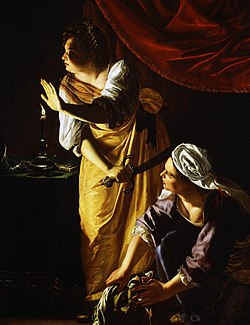Artemisia Gentileschi. Warrior Painter
- carlottaceccarini9
- Jun 25, 2022
- 4 min read
"The only woman in Italy who has ever known what painting is, and color, and impasto, and similar essentiality". (Roberto Longhi)

Documentary of 2020 directed by Jordan River, presented at the sixth edition of the International Documentary Festival Visioni dal Mondo and winner of the XXIV Terra di Siena International Film Festival 2020. Released in Italy in June 2021, now available on Prime Video, the documentary, between the other Italian and foreign awards, was in competition for the David di Donatello 2021 with a special mention for Angela Curri in the role of Artemisia.
Daughter of the painter Orazio Gentileschi, Artemisia was born in 1593, in Guido Reni's Rome, “a unique artistic center in Europe saturated with art and culture”. The painter's mother died when she was only twelve, a loss that inevitably binds her deeply to her father, whose painting studio she will attend assiduously, where she will cultivate her love for colors. Artemisia learns the art of drawing at home, not being able to access an academic path as a woman. Great lover of Caravaggio, she soon makes her "the refinement of the stroke, the taste for color, the play of shadow and light, as well as the use of real models transfigured into a powerful and more realistic than ever drama". Following the realistic Caravaggesque influence Artemisia in her early Roman years painted works such as the Madonna and Child, Santa Cecilia and Susanna and the Elders.
Artemisia's life was turned upside down by the violence suffered by Agostino Tassi, his teacher of perspective and a frequent visitor to the study-home of the Gentileschi. In 1612 the trial in court began which had a full effect on the woman forced to suffer public violence by the inquisitors to prove her virginity before her rape. Artemisia's painting becomes even more dramatic, but as strong and determined as the painter herself.
Orazio, to recover his daughter's dignity, gives her in marriage, with a reparative wedding, to Pierantonio Stiattesi, a Tuscan painter, for whom Artemisia will move to Florence, where she will be the first woman to enter the Academy of Arts and Design, starting to get commissions from important families such as the Medici. Gentileschi thus enters the circle of Florentine intellectuals, forming a deep friendship with Galileo Galilei and Michelangelo Buonarroti the Younger. The Tuscan period is among the most flourishing for the art of Artemisia, these are the years of the Allegory of inclination and of Judith who beheads Holofernes.
From the 1920s, an Italian wanderer begins for the Roman artist: she will return first to her native land where she will give birth to Giuditta with her handmaid. She will then go to Genoa, moving away from her husband, to then land in the Venetian lagoon where she paints Esther and Ahasuerus, in harmony with the Venetian painters who loved her scenic compositions. She will end her days in Naples, where she will die in 1653, not before having created masterpieces such as Clio, the Muse of History and Aurora, the Adoration of the Magi and Corisca and the satyr, the Birth of San Giovanni Battista, the Madonna and the Child with rosary. Artemisia thus confirms her talent, the ability to be able to deal with the artistic trends of the time as well as with subjects new to those usually portrayed.
During the Neapolitan period, at the height of her artistic career and recognition as a painter, Artemisia lived for a period in London and moved to her father in the Anglo-Saxon capital. In these years she produced Self-portrait as an allegory of painting and David who beheaded the head of the giant Goliath. After Orazio Gentileschi died, Artemisia was then forced to definitively abound England at the outbreak of the civil war, to return to the Neapolitan metropolis.
Outraged as soon as a young girl, in honor and love. Evil victim of a public rape trial. She who she held painting school in Naples. She who she ventured, towards 1638, in heretical England. She was one of the first women who supported with words and deeds the right to congenial work and an equality of spirit between the two sexes (Anna Banti, Artemisia, Sansoni, 1947)
A life that, like a painting, is made up of lights and shadows, light and dark, a romantic existence with dramatic tones, but which certainly has the merit of making she famous, more than her own works. An ante litteram feminist who comes to reaffirm that she wants to be recognized as a man. A heroine fighting for her dignity and independence, a war within a hostile social and artistic environment in which "she was an absolute exception". Artemisia is original not only for her lifestyle, but also for her painting: she tackles the painting of great sacred and historical subjects with a monumental structure and in perfect Caravaggesque style she paints shapes and colors that abandon conventional iconographic modules.
"Today, as then, it cannot fail to strike that evident interweaving of the story of a woman with the passion of an artist. Artemisia, an extraordinary painter, who certainly touches the heart and soul of those who contemplate her works ".
Today it is enough to mention the name of Artemisia Gentileschi to evoke a dramatic painting, populated by energetic female figures represented in a direct and uncompromising way, and which relates and integrates with the events of the artist's life (Judith Walker Mann)
The documentary ends with a tribute "to all the women who, reacting to the darkness of the world with their courage, sweep away the darkness and shed their light on the canvases of existence".
Photos by Wikipedia.org
Quotes from the post from the documentary Artemisia Gentileschi. Warrior painter





















































































Comments